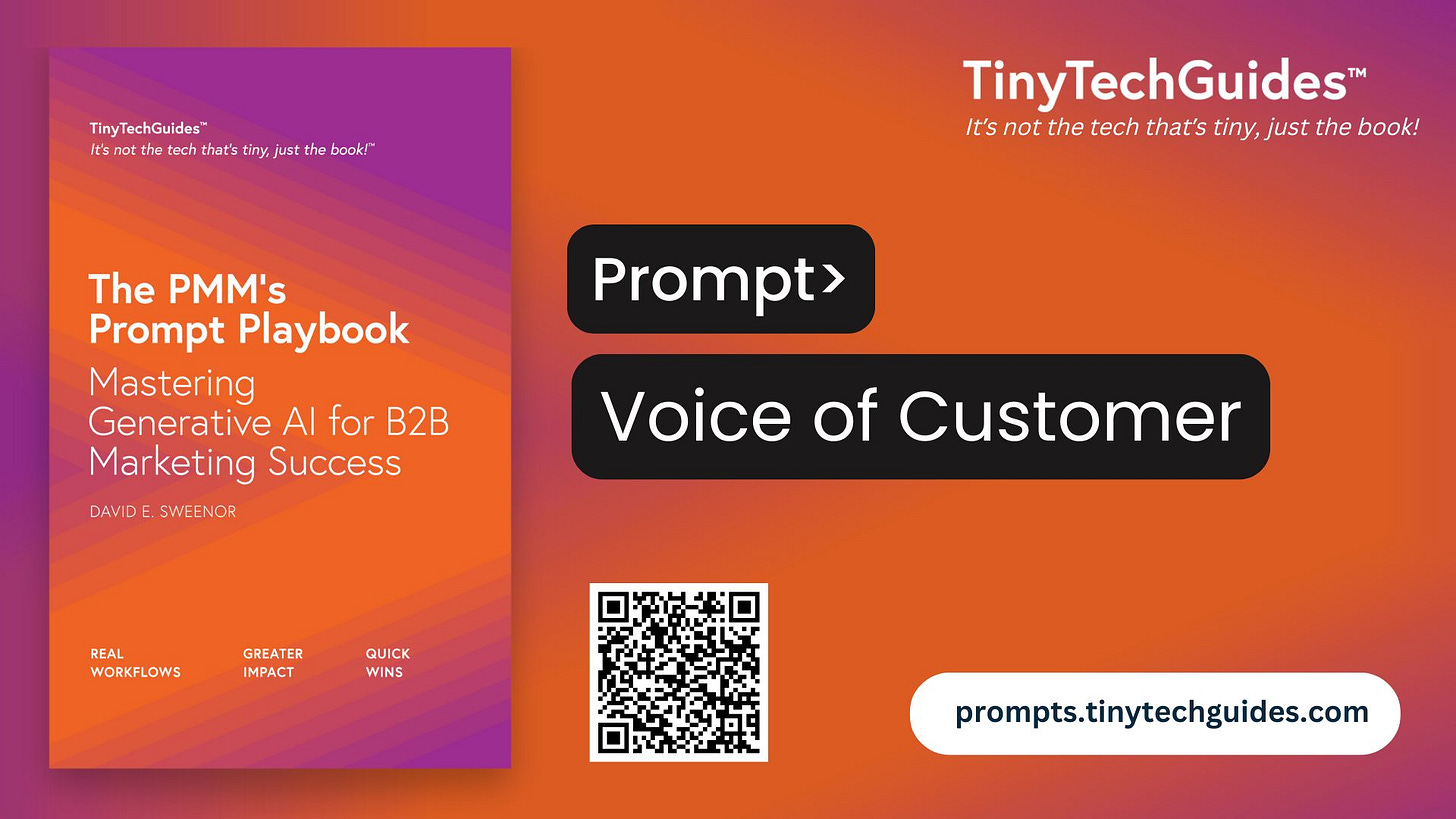Prompt Workflow: Voice of Customer
Audience Understanding
This prompt, along with 30 others, is included in The PMM’s Prompt Playbook. These cut-and-paste prompts, along with bonus prompts not in the book, will be made available to paid subscribers on a weekly basis.
Get the PMM’s Prompt Playbook and Modern B2B Marketing today!
Voice of Customer
What does this do?
The Voice of Customer (VoC) workflow systematically collects, analyzes, and synthesizes customer feedback from multiple sources—such as surveys, reviews, and support tickets—to uncover key pain points, needs, and opportunities. This process helps businesses refine their product roadmap, enhance customer messaging, and prioritize feature improvements based on real user insights. By structuring feedback into actionable themes, it ensures a customer-driven approach to decision-making.
Workflow steps
Collect and categorize VoC data from multiple channels (e.g., surveys, interviews, reviews, support tickets)
Identify recurring pain points, needs, and goals
Group insights into thematic categories for deeper analysis
Compare and synthesize feedback across different sources
Simulate customer perspectives to uncover hidden insights
Prioritize VoC themes based on frequency, impact, and strategic alignment
Translate findings into actionable recommendations for product and marketing teams
Summarize VoC insights to drive data-informed business decisions
Define input variables
-{industry=Insert your target industry, e.g., cloud-based cybersecurity solutions.}
-{solution=Insert your product/solution, e.g., automated threat detection platform.}
-{audience=Insert your target audience, e.g., IT security managers, SOC analysts, or CISOs.}
-Attach customer interviews, support tickets, reviews, etc.
Define the objective
<role/>
You are a customer insights analyst specializing in synthesizing feedback to uncover actionable themes and insights for {solution} in the {industry}.
</role>
<context/>
I have collected customer feedback from various sources, including surveys, interviews, reviews, and support tickets. I need you to analyze and synthesize this data to identify:
-Key pain points expressed by {audience}.
-Top priorities, needs, and goals.
-Recurring themes across feedback sources.
-Opportunities for product improvement and messaging refinement.
</context>
<task/>
Analyze the following customer feedback data: [Insert data: customer interviews, survey responses, reviews, or support ticket summaries.]
-Identify recurring pain points or frustrations.
-Highlight top priorities, needs, and goals expressed by users.
-Group feedback into thematic categories.
-Provide actionable insights for product improvements or refined messaging.
</task>
<format>
Provide the response in a structured format:
Recurring pain points:
—Pain Point 1: [Description].
—Pain Point 2: [Description].
Top priorities and goals:
—Priority 1: [Description].
—Priority 2: [Description].
Thematic categories:
—Theme 1: [Cluster of related feedback].
—Theme 2: [Cluster of related feedback].
Actionable insights:
—Insight 1: [Recommendation for product improvement].
—Insight 2: [Suggestion for messaging refinement].
</format>
<tone>
Analytical, user-focused, and actionable.
</tone>
Analyze feedback across channels
<role/>
You are a VoC expert analyzing multichannel feedback to uncover patterns and trends.
</role>
<context/>
I have collected customer feedback from multiple sources, including:
-Online reviews (e.g., G2, TrustRadius).
-Survey responses.
-Customer interviews.
-Support tickets and chat logs.
I need you to synthesize insights across these sources and identify common themes, discrepancies, and opportunities.
</context>
<task/>
For each feedback channel:
Summarize the most frequent pain points and needs mentioned.Identify any differences or discrepancies in feedback between channels.Combine insights into unified themes that apply across all channels.
</task>
<format>
Provide the response as follows:
-Channel summaries:
—Surveys: [Top pain points, needs, and patterns].
—Reviews: [Key frustrations, priorities, and recurring themes].
—Support Tickets: [Issues most frequently reported].
—Interviews: [Deeper insights into user challenges and goals].
-Cross-channel themes:
—Theme 1: [Description of theme and supporting examples].
—Theme 2: [Description of theme and supporting examples].
-Discrepancies:
—[Highlight differences in feedback between channels and why they might exist].
</format>
<tone>
Structured, comparative, and insight-driven.
</tone>



